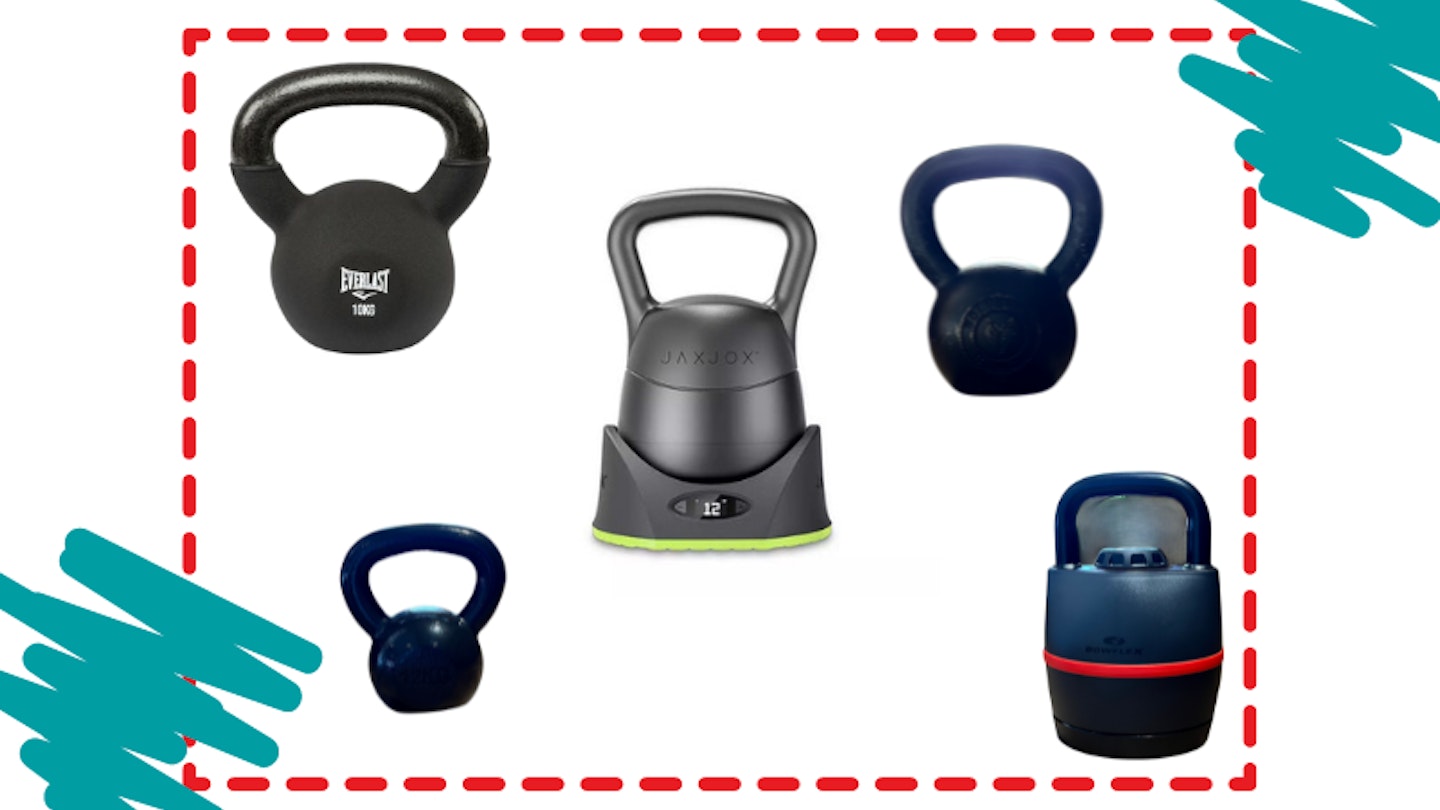If you’re a gym regular but always use the treadmill, exercise bike or other cardio equipment, allow me to introduce you to the kettlebell. NHS exercise guidelines state that everyone should be doing some form of strengthening exercises on at least two days a week and aiming for 150 minutes of moderate intensity exercise per week overall or 75 minutes of vigorous activity.
A kettlebell – which looks like a cannon ball with a handle – is one of the most versatile pieces of gym equipment you can buy. There’s not a lot you can’t do with them, and using a kettlebell will cover all of your cardio, strength and fitness needs.
I have been teaching kettlebell classes to women for four years now, and we’ve tried and tested many different bells. Below, I’ve listed some of our favourites as well as some points to consider when thinking about which one to buy.
What is a kettlebell?
A kettlebell is essentially a ball shaped weight with a handle that comes in a variety of sizes to meet your strength capabilities.
Designed with a top handle, the majority of the weight sits in the bulk of the bell and can be used for a variety of exercises, including kettlebell swings, squats, presses and deadlifts. Kettlebells can be used in place of dumbbells and barbells for a variety of exercises, and they are great at working your cardiovascular system (heart and lungs) at the same time as building strength.
Kettlebells might look scary, but if you learn to use them properly they are very safe. They’re also a cost-effective way of keeping fit; you only need one or two bells to really transform your fitness at home.
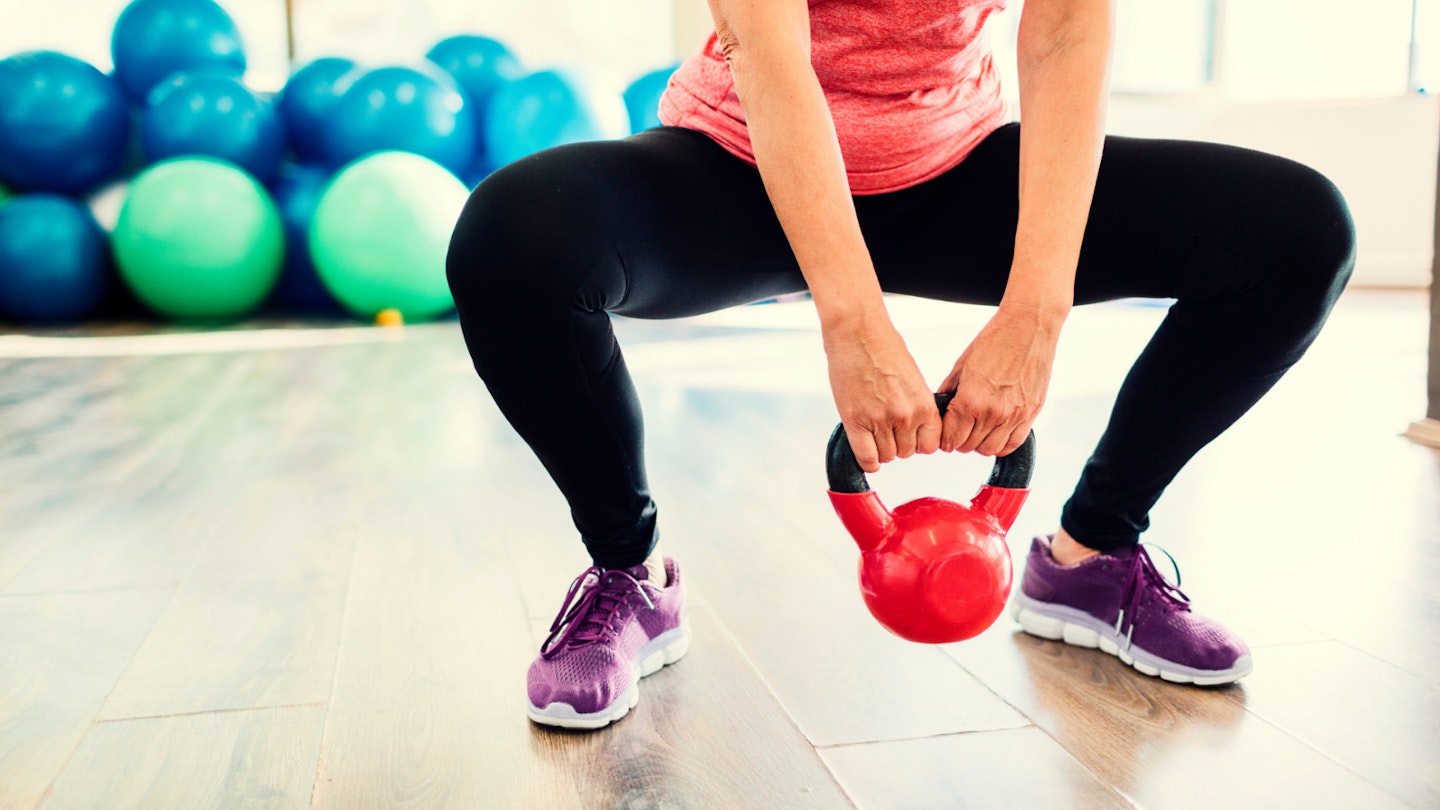
What are the best kettlebell features to look out for?
If you're looking to buy your first kettlebell or want to make sure you're getting the best for your money, there are a few features you'll need to consider and look out for.
Material: Kettlebells are usually made of cast iron - though you can get vinyl-coated kettlebells that can provide better protection for home use. However, if the handle is vinyl coated, it may become more slippery as you sweat. Cheaper bells will be hard plastic and filled with sand. Although they're better for your wallet, they tend to be larger and more unwieldy to use.
Size: Kettlebells of the same weight can come in different sizes, depending on what they're made of, with some being more rounded, and others being more elongated. It's also worth keeping in mind that cast iron kettlebells will increase in size with the weight.
Weight: Kettlebells come in kg weights, with large jumps between them. The idea is you become wholly proficient in one size bell before moving up to the next. Weights are generally as follows: 4kg, 6kg, 8kg, 10kg, 12kg, 16kg, 20kg, 24kg. They range right up to 44kg and beyond.
Handle: While most kettlebell handles are rounded, you can get competition kettlebells that have a compact square handle designed to be used for one hand. You should also consider the size of the handle as if it is too large for your hand, it could be awkward to work with and may affect your performance.
Grip: You want to ideally pick a kettlebell with a good handle grip, where you can grip your whole hand around the bar. It's very important to be able to feel the handle of the kettlebell when exercising to make sure your grip is firm. For this reason, I wouldn't recommend gloves.
What weight kettlebell should I use?
Your starting point with kettlebells will depend on your own personal fitness levels. When I have new clients, I generally start them with an 8 or 10kg bell for leg dominant moves such as swings, squats and deadlifts, and a 6kg bell for upper body work like overhead presses.
As a rough guide for women over 50, being able to confidently use 12kgs bells is the sign of strength, and 16 or 20kg for men.
Now you know what to look out for, here is our list of the best kettlebells available to buy.
The best kettlebells tried and tested
All the kettlebells listed below have been tried and tested by my kettlebell club. Between us all we have used them for a variety of moves both in a class situation and at home.
Best kettlebell overall
 Yours
Yours wolverson-fitness.co.uk
Fitness brand Wolverson have a reputation for producing quality items and their black series kettlebells are no exception. This bell is easily the best we’ve tested and it’s honestly hard to find anything wrong with it.
The handle to bell clearance is great, so you can use it with two hands or one. The handle itself isn’t too chunky either, and it’s in good proportion to the bell. We used it for all the usual kettlebell moves plus many others.
Wolverson bells are hand-finished in a non-abrasive coating. Now, I’ve been coaching kettlebells for many years and I can tell you if you’re doing a lot of high-volume kettlebell work your hands will be affected, but these bells minimise any damage plus they’re easy to grip and non-slip.
This bell is more expensive than other choices but if you want a top-quality kettlebell that’s virtually flawless, this is the one for you. The majority of my kettlebell collection is made up of these bells and I would recommend them time and again.
Pros
- Single piece casting to ensure quality
- Has a 3-year guarantee
- Non-abrasive finish
Cons
- More expensive than other options but the quality makes it worth the cost
Best value kettlebell
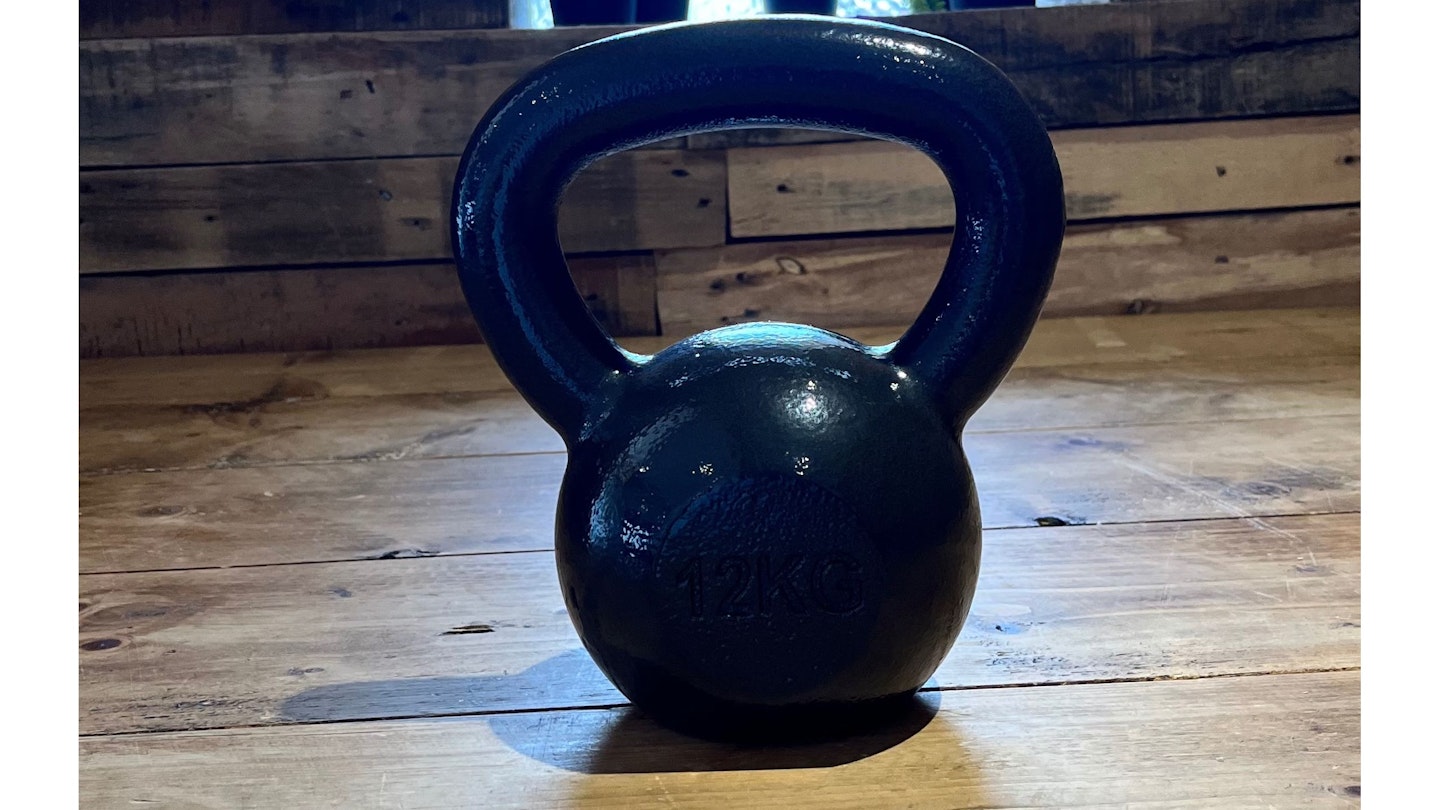 Yours
YoursAmazon have really delivered with their ‘basics’ kettlebell range. Cast iron bells are always the best quality bells to buy, but this does make them more expensive. However, Amazon have kept the price point low.
The bell and handle are made from one piece, as opposed to having the handle fused to the bell. This is a mark of a good quality bell. It also has a flat bottom, so the bell is sturdy and will rest where you put it.
We felt this bell is a great option for beginners. We tested a 12kg bell, but the range runs from 6-20kgs so there’s plenty of options. The handle might be a little large for some but to be honest, it’s in keeping with the size and shape of most cast iron kettlebells.
We did notice a rough spot on the underside of the handle, which became more noticeable when trying to swing the bell. We sorted it out with a bit of wire wool though and given the price point of the bell, we didn’t mind too much.
Pros
- Cast iron kettlebell
- Quality kettlebell for a great price
Cons
- Handle might be a little too large for some
Best compact kettlebell
Best beginners kettlebell
 Argos
Argoswww.argos.co.uk
When Argos first stocked these bells, I told all my class, and we sold our local branch out in two days. For home fitness, especially if you’re a beginner, the pro fitness range is a great choice and offers excellent value for money.
The bells are cast iron and they come in a range of sizes (we tested an 8kg one). The actual bell part is relatively compact, but we all felt the handle was a bit too thick. However, this does also mean it’s great for getting to grips with kettlebell moves like deadlifts and swings because it feels solid and strong.
There’s not a lot you can’t do with these bells in the smaller sizes, but as you move up the weight range they do get bigger. I also own the 24kg version of this bell, and it’s hard to fit it between your legs when swinging.
Pros
- Good value for money
- Cast iron bell
Cons
- Handles are very thick
Best neoprene coated kettlebell
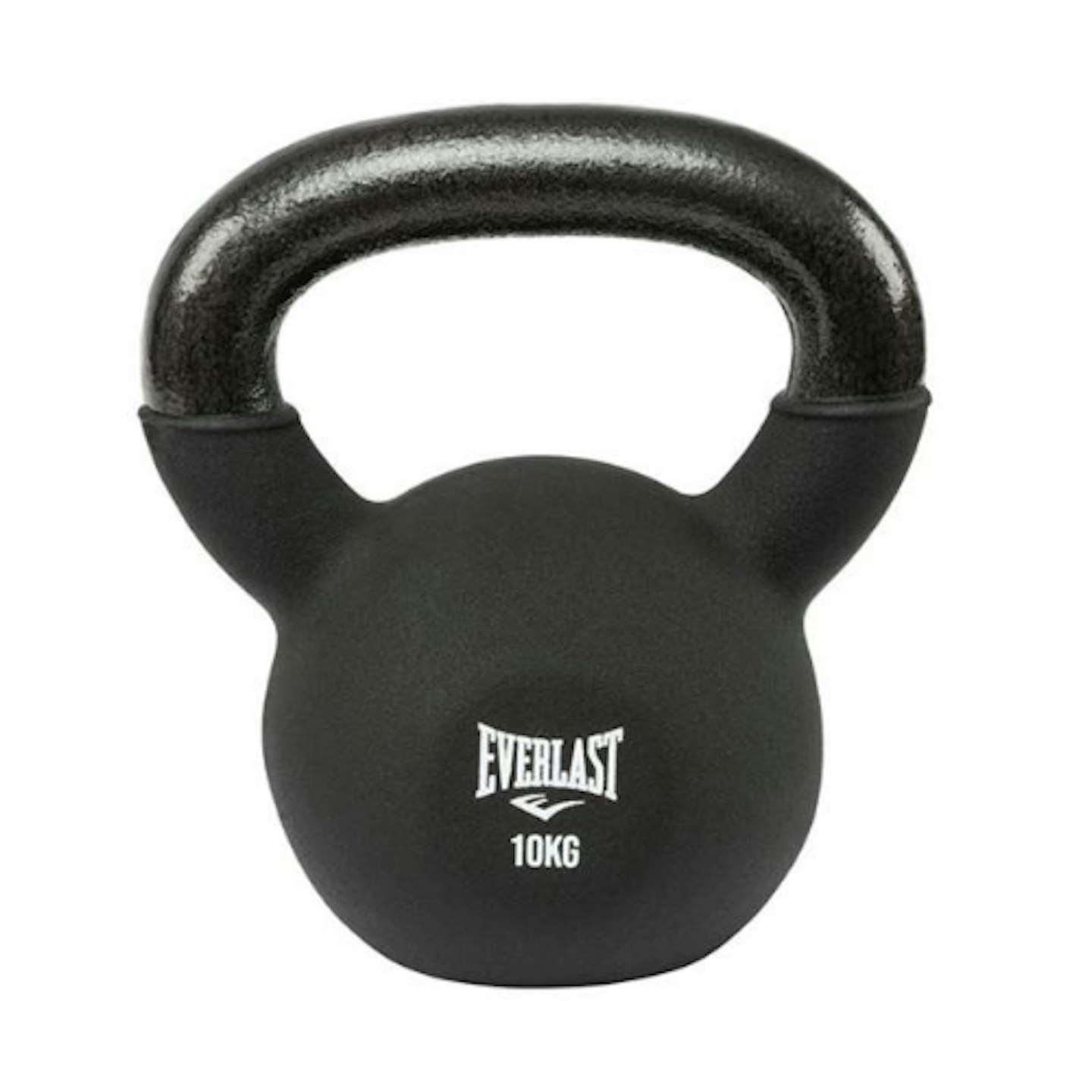
www.sportsdirect.com
Neoprene coated bells are ideal if you want to minimise damage to your floor, as they’re less likely to scratch or mark surfaces such as laminate or lino. The neoprene also offers good grip to the floor making it less likely to slip or skid.
This Everlast range is great quality and value, but they only go from 4-12kgs, so if you want bigger bells you’ll need to look elsewhere.
We really like using this bell. All of us felt it was ideal for home workouts because of its coating. The only issue a couple of us had was with the neoprene jacket. When holding it for certain moves, such as a squat or halo (when you circle the bell around the head, rotating the shoulders), the neoprene rubbed against our hands. However, it’s possible to avoid that by just holding the bell slightly differently so shouldn’t be a major issue.
Pros
- Neoprene coating is less likely to damage floors
- Cast iron
Cons
- Jacket on bell can rub against hands in certain moves
- Fewer weight options in the range than other bells we tested
Best adjustable kettlebell
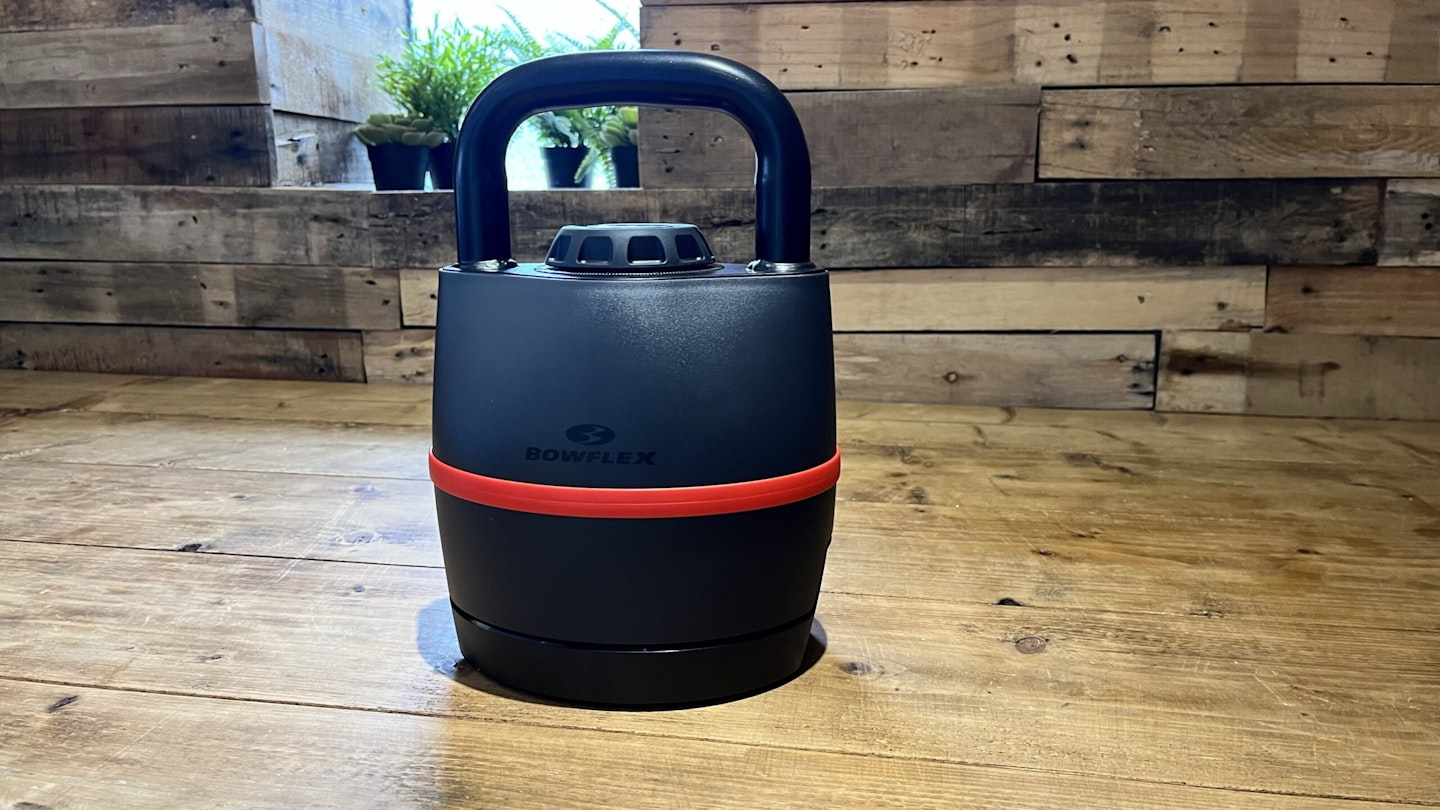 Yours
Yours Bowflex are synonymous with adjustable weights – their adjustable dumbbells are amazing – so it’s no surprise they’ve branched out into kettlebells as well.
This adjustable kettlebell ranges from 3.5kg to 18kg. Although it’s pricey, buying that number of kettlebells individually would set you back just as much, and be harder to store. It really is a one-piece home gym set-up. And it’s so easy to adjust. You just sit the bell in the base, turn the dial to the weight you want, and lift it out. To change it, you just put it back on the base and repeat the process.
The kettlebell is sturdy and feels good quality. The handle is a great size, too, but it does get slippery with sweat, so use chalk if needed.
My main issue with this bell, which we all agreed on, is that it’s not the most comfortable to swing due to its shape. However, there are many other moves that it’s great for, like squats or presses. This is our pick of adjustable kettlebells because of its versatility.
Pros
- Space-saving and a great weight range
- Easy to adjust with 1-click
Cons
- Bulky shape to swing through the legs
Best digital kettlebell
The JaxJox adjustable kettlebell is eye-catching in its design and is definitely something I wouldn’t mind having on display at home. It works on the same principal as the Bowflex, but this one is adjusted via the digital display.
It’s easy enough to set up. You have to charge the base first, but it’s difficult to get the weight selection locked on kgs instead of lbs. I also found it frustrating to adjust via the display and preferred the Bowflex’s dial.
It swings nicely though, and can be used for all the normal kettelebell exercises. Like the Bowlfex, it’s pricey but much more cost-efficient than buying individual bells and easier to store. The handle is smooth and nice to hold as well, and it didn’t slip.
It also has an app, which will track your progress for you and offer home workouts to try. I liked the workouts on offer, though I felt they were more intermediate to advanced than beginner.
Pros
- Comes with an app and extra workouts
- Digital display
Cons
- Handle gets quite slippery
Best vinyl kettlebell
 Yours
Yours The York vinyl kettlebell is a good choice if you’re looking to begin weight training for women. If you want to learn kettlebells, however, then I’d suggest one of the other bells on the list.
This kettlebell is solid, with a flat bottom, so it’s ideal for starting things such as deadlifts (lifting the bell from the floor) or squats. But it’s also very big, owing to it being made of plastic and sand rather than cast iron. Because of that, the 12kg option, which we tested, is almost impossible to swing as it’s too wide to fit between our legs.
What I will say is York do a whole range of these kettlebells, and the smaller weights aren’t as bulky, so if you know you want a 4 or 6kg bell, for example, then this would be a great choice as a beginner. The finish is smooth, though there is a join on the underside of the handle, and there’s plenty of room to get two hands on it.
Pros
- Not expensive
- Solid bell good for beginners to weight training
Cons
- Very bulky - can't really do kettlebell swings with the heavier bells in the range
How to use a kettlebell
You've got the right kettlebell for size, weight, and grip, but how do you use it?
Make sure that you can lift the kettlebell comfortably, and that you can grip it securely. Always keep good posture and remember the two most important points:
-
Shoulders and ears aren't friends - when doing upper body moves in particular, don't let your shoulders rise up. Keep them down, away from your ears to avoid shoulder or neck injuries.
-
Kettlebell moves are predominantly from your legs and core - always keep your tummy tight, glutes squeezed tightly, and back neutral. Don't arch or round your back - thin of yourself as an upright plank.
When performing exercises, form and technique is the most important thing so you don't risk injury. Make sure to focus on the areas you are trying to work i.e. the abdominals, glutes, shoulders, or quads, and make sure not to let your back take up the work.
If you're planning to increase the weight of your kettlebell, make sure you are fully proficient in all the moves you do before moving up to avoid injury.
At the end of the day, it's better to use a lighter weight and do the exercises correctly than use a heavier kettlebell.

How to do a kettlebell swing
When you get started with your kettlebell, you should learn the basics to get your form down to a tee. One of the easiest basic moves to get to grips with is the kettlebell swing.
However, it's not just a matter of swinging the weight, there are form factors you need to follow. Even though you are swinging the kettlebell with your arms, the move is not about your arm strength as the power is driven from your hips and glutes to propel the kettlebell forward.
- Place your feet a little more than hip-distance apart, and hold the kettlebell using both hands in the centre. Make sure there is enough space for the kettlebell to swing between your legs.
- Bend at your knees and push your hips backwards so that your bottom sticks out, you will need to keep your upper body straight and your core engaged so that the kettlebell doesn’t pull on your lower back.
- As you swing, the kettlebell raises and you drive your hips forwards, and give your glutes a little squeeze as you feel the weight reach the top arc of your movement. The kettlebell swing is essentially a standing hip thrust, rather than a squat, with the weight naturally swinging upwards.
Still unsure? You can follow tutorials on YouTube to help you master your swing and other beginner moves. Check out this beginner's workout from The Body Coach AKA Joe Wicks:
What are kettlebells good for?
A kettlebell workout can come with a whole host of benefits that'll support your fitness journey or goals:
• A kettlebell workout is a great way to burn calories if you're looking to lose weight. The American Council on Exercise (ACE) found that the average person burns around 20 calories per minute during a standard kettlebell workout.
• Kettlebells can help to improve your core strength, stability, posture, balance, and coordination.
• If you have chronic pain, kettlebell exercises can help improve your joint health, mobility, and flexibility, thanks to the strengthening of the muscles and kettlebell handle design that mirrors everyday activities.
• Kettlebells are easier to store than dumbbells and barbells, and more affordable than other workout machines.
• Kettlebell workouts can help to tone and shape your body.
• Kettlebells provide a simple but effective workout! You can achieve a fully functional workout with just one piece of equipment.
Becky Fuller is a senior digital writer for Yours.co.uk. She is also a fully qualified personal trainer and strength coach, specialising in fitness and wellbeing for over 50s. Prior to joining Yours, Becky was a fitness writer for Saga, and a freelance entertainment and theatre journalist. Becky is passionate about helping people to move well and discover the many benefits of strength training.
